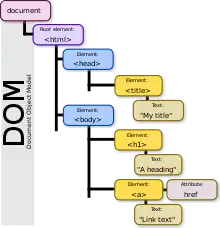文档对象模型
Document Object Model的歷史可以追溯至1990年代後期微軟與Netscape的“瀏覽器大戰”(browser wars),雙方為了在JavaScript與JScript一決生死,於是大規模的賦予瀏覽器強大的功能。微軟在網頁技術上加入了不少專屬事物,既有VBScript、ActiveX、以及微軟自家的DHTML格式等,使不少網頁使用非微軟平台及瀏覽器無法正常顯示。DOM即是當時醞釀出來的傑作。
 在HTML文档中DOM层级的例子 | |
| 首次出版 | 1998年10月1日 |
|---|---|
| 最新版本 | DOM4[1] 2015年11月19日 |
| 组织 | World Wide Web Consortium, WHATWG |
| 基础标准 | WHATWG DOM Living Standard W3C DOM4 |
| 缩写 | DOM |
| HTML |
|---|
| 比较 |
標準化
W3C對DOM進行標準化的動作,目前已經推行至第四代。
Level 1
- 文档对象模型(DOM)1级规范
- 支援XML 1.0
Level 2
- Document Object Model (DOM) Level 2 Core Specification
- XML 1.0與命名空間
- Document Object Model (DOM) Level 2 HTML Specification
- HTML 4.0x、XHTML 1.0
- Document Object Model (DOM) Level 2 Views Specification
- Document Object Model (DOM) Level 2 Style Specification
- 支援CSS與CSS Level2
- Document Object Model (DOM) Level 2 Events Specification
- 支援HTML 4.01
- Document Object Model (DOM) Level 2 Traversal and Range Specification
Level 3
参考文献
- All versioning refers to W3C DOM only.
外部連結
- (英文) W3C Document Object Model 页面存档备份,存于
参见
- SAX:Simple API for XML
This article is issued from Wikipedia. The text is licensed under Creative Commons - Attribution - Sharealike. Additional terms may apply for the media files.
